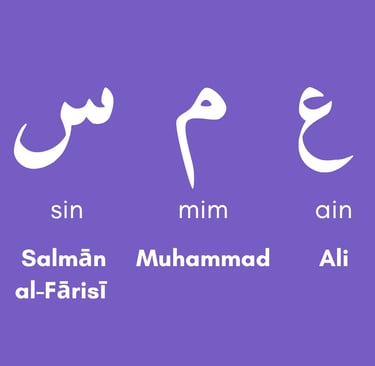Who are tha Alawites ?
The Alawite community remains one of the most enigmatic minorities in the Middle East. Projected onto the international stage through its central role in contemporary Syria under the Assad family regime, it is still largely misunderstood.
11/6/20256 min read


The Roots of a Dissident Faith
Alawism traces its origins to the 9th century in southern Iraq. Its founder, Ibn Nusayr, a close follower of the eleventh Shiite imam, is said to have received a divine revelation from him. Quickly considered heretical by mainstream Islam, his disciples, the Nusayris, became targets of persecution, prompting them to migrate in the 10th century to the mountains of northwestern Syria. It was in this coastal region that they established their community and lived on the margins of major centers of power.
An alternative theory, based on the writings of Pliny the Elder, suggests a pre-Islamic origin, linking the community to a people called the Nazareni who supposedly lived in the same area. However, this hypothesis remains marginal compared to the narrative of Shiite dissent.
Centuries of Oppression and Ibn Taymiyya's Fatwa
For nearly a millennium, the history of the Nusayris was a litany of massacres and oppression extending to the end of the Ottoman Empire. The most notable event was the fatwa issued in the 14th century by the famous Sunni theologian Ibn Taymiyya. This religious decree cemented the status of the Nusayris as pariahs and infidels in the eyes of mainstream Islam.
The text called for their complete eradication, deeming them more harmful than "belligerent infidels." The fatwa forbade marriage with them and justified their execution and the seizure of their property. This ruling provided a doctrinal justification for future persecutions and is regularly invoked by contemporary jihadist groups to legitimize their fight against the former Syrian regime and the Alawite community.
Rise to Power in the 20th Century
The transformation of the Alawites' status in the 20th century was remarkable. Confined to their mountains, they were officially recognized as Muslims only in 1932, following a fatwa by the Grand Mufti of Palestine, Haj Amin al-Husseini, which was motivated more by anti-imperialist politics than genuine religious recognition.
A major turning point occurred under the French mandate in Syria. French authorities renamed the community "Alawite," meaning "disciple of Ali," and granted them an independent state from 1922 to 1936. This policy placed them in a favorable position within the military and administrative apparatus, facilitating their rise after the end of the mandate in 1946. Alawite officers, already well established in the army, played a decisive role in the Baathist coup of 1963, marking the beginning of their political dominance. This process was consolidated by Hafez al-Assad in the 1970s. To strengthen his power, he promoted the massive integration of his co-religionists into the army and administration, creating a network of loyalists that became the pillar of his regime.


Beliefs and Society: An Esoteric and Complex Religion
Although historically linked to Shiism, Alawite doctrine incorporates significant borrowings from Manichaeism (dualistic religion opposing good and evil), Gnosticism (salvation through secret knowledge), and pre-Islamic philosophies. At the heart of their faith is a divine trinity symbolized by the Arabic letters Ain-Mim-Sin (ع-م-س). Each letter represents a manifestation of the divine essence:
• Ali (ع): Son-in-law of Prophet Mohammed, regarded as the Ma’nâ (the Sense, the Essence), the very incarnation of God on earth.
• Mohammed (م): Seen as the Hijab (the Veil) or Ism (the Name), revealing Ali’s divinity without being God himself.
• Salman al-Farisi (س): Companion of the Prophet, acting as Bab (the Gate), the initiatory intermediary leading to knowledge of the Veil and the Essence.
In other words, if Ali is the divine Reality (Ma’na), Mohammed is the Prophet who reveals it (Hijab), and Salman is the guide leading to understanding this revelation (Bab).


Reincarnation and the Status of Women
Another central tenet of Alawite faith is the belief in metempsychosis, or the transmigration of souls. This cycle of reincarnation is, however, reserved exclusively for men. After death, a believer's soul is reborn into a new human body to continue its spiritual journey through seven cycles, before, if virtuous, joining the stars.
Conversely, the souls of infidels or sinful believers are condemned to reincarnate in inferior creatures, such as insects, or even in inanimate objects as punishment.
The community's view of women is particularly distinctive. Women are excluded from religious life and initiation because, according to the sheikhs, they do not possess enough reason to grasp the secrets. Considered lacking a soul, they do not participate in the cycle of reincarnation, and their existence ends with their physical death, like that of an animal.
An Initiatory and Clan-Based Society
Alawite religion is initiatory and exclusively male. Its secrets are transmitted only to young men deemed worthy, born to both Nusayri father and mother. This culture of secrecy is reinforced by the principle of Taqiyya (concealment of faith).
The social structure is hierarchical. The sheikh plays a crucial role: he transmits sacred knowledge to the initiate and becomes his "spiritual father," to whom obedience is owed. The community is traditionally organized around four major clan branches:
• Al-Kalbiyya (from which the Assad family originates)
• Al-Haddadin
• Al-Khayyatin
• Al-Matawira
Branches, Syncretism, and Holy Book
The Alawite community is itself divided into several sects, whose beliefs diverge on certain cosmological points. The main ones are:
Haidaris: Named after al-Haidarah (the lion), a nickname for Ali, they focus on Ali, considered the Ma’nâ (the Sense) and the Sky. They are described as the faction most open to foreign beliefs.
Chamalis (or Chamsis): Worshipers of the Sun (Chams), whom they associate with Mohammed (the Name/Ism), the Veil of Ali. They pray facing the rising and setting sun.
Kalazis (or Qamaris): Worshipers of the Moon (Qamar), whom they associate with Salman al-Farisi (the Gate/Bab). They believe Ali resides in the Moon, forming its dark part.
Ghaibis: Named after the Absence (al-Ghaibah) of God, identified with invisible air, because God manifested and then became absent.
Alawites celebrate not only Muslim holidays but also major Christian festivals such as Christmas, Easter, and Epiphany. Their main religious book is the Kitab al-Majmu (The Book of the Collection). Composed of sixteen chapters or suras, it is the foundation of the religion and the core text of initiatory teaching.


Post-2011 Future: an Existential Fear
Since the Syrian uprising of 2011, the Alawite community faces a tragic dilemma. Its fate has become inextricably linked to that of the Assad regime, placing it in a position where the fall of power is perceived not as liberation but as a direct existential threat. In response to the insurgency, most of the community sided with the regime. This allegiance was not mere complicity but a deep fear of seeing power fall to an opposition dominated by radical Islamist currents. One slogan summed up their position: Anta ma’Assad anta ma’ nafsak (You are with Assad, you are with yourself). For many Alawites, defending the regime became a fight for survival.
However, portraying the community as a monolithic supporter of the regime is an oversimplification. Before 2011, a wave of revolt was already emerging in the Alawite mountains against Bashar al-Assad, accused of betraying them through his closeness to Sunni economic elites. After 2011, Alawite opponents were caught in an impossible position, torn between hatred of the dictatorship and fear for the safety of their relatives. Figures such as writer Samar Yazbek have embodied opposition to the Assad regime since the uprising began.
Post-Assad Scenario: Targeted Massacres
In early March 2025, a group loyal to the former regime attacked a checkpoint controlled by Al-Sharaa soldiers, according to a government report. In retaliation, the Alawite community became the target of massive violence: a Syrian official committee reported 1,426 people, including around 90 women, killed between March 6 and 9 in coastal regions. Human Rights Watch described executions and indiscriminate shootings. According to Amnesty International, at least 36 Alawite women and girls were abducted between February and June 2025 in the governorates of Latakia, Tartus, Homs, and Hama.
Sources:
The Nusayris - Alawis, Yaron Friedman
Histoire et religion des Nosairis, René Dussaud
Syria: Authorities must investigate abductions of Alawite women and girls
Massacre des alaouites : la chaîne de commandement remonte jusqu'à Damas, selon une enquête de Reuters.
